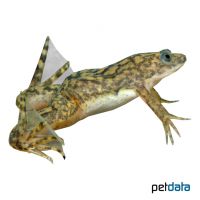African Clawed Frog (Xenopus laevis)
| African Clawed Frog Xenopus laevis | |
|---|---|
| Name | African Clawed Frog |
| Name Lat. | Xenopus laevis |
| Family | Tongueless Frogs |
| Family lat. | Pipidae |
| Order | Frogs & Toads |
| Order lat. | Anura |
| Origin | Africa |
| Habitat | Ponds |
| Diet | Carnivore |
| Behavior | Predatory |
| Keeping | Pair, group |
| Care Level | Moderate |
| Breeding | Moderately difficult |
| Housing | Aquarium |
| Life Span | 20 years |
| Protection | No |
| Metric Units | |
| Size | 10 cm |
| Temperature | 20-30 °C |
| Housing Size | 80 x 40 x 50 cm |
| US Units | |
| Size | 4" |
| Temperature | 68-86 °F |
| Housing Size | 30" x 15" x 20" |
Distribution and habitat
The original distribution area is weedy waters south of the Sahara, in Angola, Namibia, Swaziland, Malawi and Zimbabwe. Due to improper handling by humans, the animals have also settled in the south of the USA and partly in Europe.
Maintenance
For 1-2 animals, the minimum aquarium area is 3,200 cm² with a minimum water level of 40 cm. This corresponds to an aquarium with a base area of e.g. 80 x 40 cm. An additional 500 cm² of surface area must be provided for each additional animal. The aquarium should be placed in a quiet place without sunlight.
They need a partly densely planted aquarium with some plants flooding to the water surface as well as roots, clay tubes and stone structures (caves) as hiding places. A substrate of sand or fine gravel and some subdued light (floating plants) is ideal
Water quality must be that required for average freshwater fish keeping. No ammonia, ammonium and nitrite should be detectable and the nitrate value should not exceed 100 mg/l. To ensure water quality, a filter adapted to the size of the aquarium is required.
| Water temperature | 20-30 °C |
The lighting has to correspond to the species-appropriate day-night rhythm.
Diet
They prefer live food such as tubifex, mosquito larvae, daphnia and enchytraea, which are also well accepted frozen, plus commercially available frozen special food mixtures, supplemented with a high-quality, protein-rich dry food (granules, flakes, pellets). Regular and varied feeding promotes health and prevents deficiency symptoms. Only as much should be fed as is eaten immediately (in a maximum of 10 minutes).
Behaviour and compatibility
When kept in groups, the number of females should predominate. These voracious prey predators are crepuscular to nocturnal. Small fish and dwarf clawed frogs are considered food.
Reproduction and breeding
Females are much larger than males at the same age and have three lobed appendages on the cloaca. During spawning, which can take up to five days, the female attaches up to 1,000 eggs mostly to aquatic plants. For rearing, frogspawn should be placed in a separate breeding tank, as the parents eat spawn and larvae. After 2-3 days, larvae about four millimeters in size hatch. The transformation (metamorphosis) is completed after about 2 months.
In a community tank breeding is hardly possible, because the young are easy prey
Important
They live permanently under water (aquatile) and do not go on land. To breathe, they come to the surface of the water. The aquarium must be very well covered to prevent them from escaping. Males can "click" sounds
Like all amphibians, they are alternately warm (poikilothermic), unable to regulate their own body temperature, but adapt themselves and their metabolism to environmental conditions. They can live 20-30 years.
The well-being of the animals should be checked regularly. Temperature should be checked daily, pH, hardness and nitrate levels at least every 14 days. Regular partial water changes are recommended, even when contaminant levels have not yet reached the upper limit. Sudden changes in water quality should be avoided. Newly introduced animals must be accustomed slowly to the water in the aquarium.
Further literature can be found in your pet store.
References
Text: petdata; Image: petdata
Source: ENGELMANN (2006): Zootierhaltung - Tiere in menschlicher Obhut: Reptilien und Amphibien, Harri Deutsch Verlag; VDA & DGHT (2006): Haltungsrichtlinien für die Haltung von Anuren
- Gemäß § 21 Abs. 5 Tierschutzgesetz idgF
